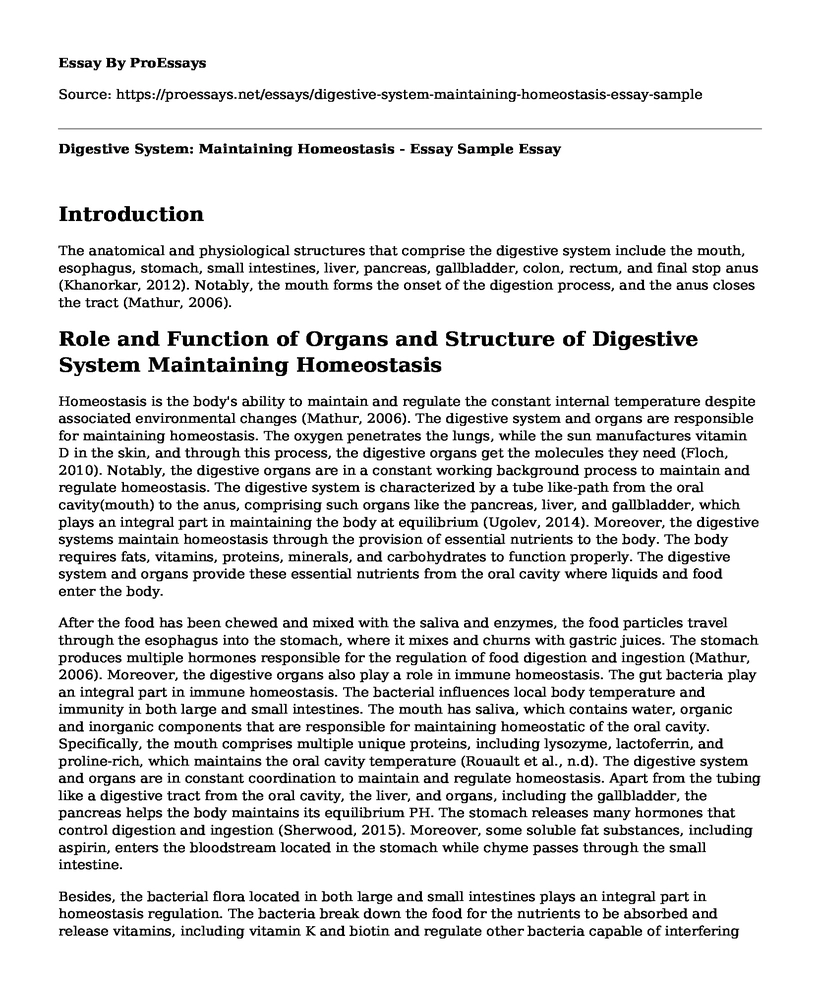Introduction
The anatomical and physiological structures that comprise the digestive system include the mouth, esophagus, stomach, small intestines, liver, pancreas, gallbladder, colon, rectum, and final stop anus (Khanorkar, 2012). Notably, the mouth forms the onset of the digestion process, and the anus closes the tract (Mathur, 2006).
Role and Function of Organs and Structure of Digestive System Maintaining Homeostasis
Homeostasis is the body's ability to maintain and regulate the constant internal temperature despite associated environmental changes (Mathur, 2006). The digestive system and organs are responsible for maintaining homeostasis. The oxygen penetrates the lungs, while the sun manufactures vitamin D in the skin, and through this process, the digestive organs get the molecules they need (Floch, 2010). Notably, the digestive organs are in a constant working background process to maintain and regulate homeostasis. The digestive system is characterized by a tube like-path from the oral cavity(mouth) to the anus, comprising such organs like the pancreas, liver, and gallbladder, which plays an integral part in maintaining the body at equilibrium (Ugolev, 2014). Moreover, the digestive systems maintain homeostasis through the provision of essential nutrients to the body. The body requires fats, vitamins, proteins, minerals, and carbohydrates to function properly. The digestive system and organs provide these essential nutrients from the oral cavity where liquids and food enter the body.
After the food has been chewed and mixed with the saliva and enzymes, the food particles travel through the esophagus into the stomach, where it mixes and churns with gastric juices. The stomach produces multiple hormones responsible for the regulation of food digestion and ingestion (Mathur, 2006). Moreover, the digestive organs also play a role in immune homeostasis. The gut bacteria play an integral part in immune homeostasis. The bacterial influences local body temperature and immunity in both large and small intestines. The mouth has saliva, which contains water, organic and inorganic components that are responsible for maintaining homeostatic of the oral cavity. Specifically, the mouth comprises multiple unique proteins, including lysozyme, lactoferrin, and proline-rich, which maintains the oral cavity temperature (Rouault et al., n.d). The digestive system and organs are in constant coordination to maintain and regulate homeostasis. Apart from the tubing like a digestive tract from the oral cavity, the liver, and organs, including the gallbladder, the pancreas helps the body maintains its equilibrium PH. The stomach releases many hormones that control digestion and ingestion (Sherwood, 2015). Moreover, some soluble fat substances, including aspirin, enters the bloodstream located in the stomach while chyme passes through the small intestine.
Besides, the bacterial flora located in both large and small intestines plays an integral part in homeostasis regulation. The bacteria break down the food for the nutrients to be absorbed and release vitamins, including vitamin K and biotin and regulate other bacteria capable of interfering with the PH from entering the body (Sherwood, 2015). The liver produces bile salt that travels through the intestine to blend fats, thus making absorption and digestion easier. Moreover, the bile salt concentration and storage take place in the gallbladder and penetrate the intestines through the bile duct. The digestive bicarbonate and enzymes are produced by the pancreas, in which the bicarbonate assists in the neutralisation of acidic contents in the chyme passing from the stomach to the small intestines. An increase in the pH provides an effective environment for the digestive enzymes' functions efficiently (Sherwood, 2015).
References
Digestive system (Human). (2005). Van Nostrand's Scientific Encyclopedia. https://doi.org/10.1002/0471743984.vse2560
Floch, M. H. (2010). Role of the stomach indigestion. Netter's Gastroenterology, 106-107. https://doi.org/10.1016/b978-1-4377-0121-0.50046-5
Shankar, S. (2012). Physiological anatomy and innervations of the digestive system. Insights in Physiology, 139-139. https://doi.org/10.5005/jp/books/11552_24
Lee, D., & Hong, J. H. (2020). The fundamental role of bicarbonate transporters and associated carbonic Anhydrase enzymes in maintaining ion and pH homeostasis in non-secretory organs. International Journal of Molecular Sciences, 21(1), 339. https://doi.org/10.3390/ijms21010339
Mathur, K. (2006). Salivary secretion: Digestion in the mouth. Short Textbook of Physiology, 571-571. https://doi.org/10.5005/jp/books/10766_98
Rouault, T. A., Gordeuk, V., & Anderson, G. (n.d.). The central role of the liver in iron storage and regulation of systemic iron homeostasis. The Liver, 235-250. https://doi.org/10.1002/9780470747919.ch16
Sherwood, L. (2015). Human physiology: from cells to systems. Cengage learning. https://doi.org/10.1102/9780970747919.ch26
Ugolev, A. M. (2014). Digestive processes in the small intestines of higher animals. The role of membrane digestion. Physiology and Pathology of Membrane Digestion, 9-54.
Cite this page
Digestive System: Maintaining Homeostasis - Essay Sample. (2023, Aug 01). Retrieved from https://proessays.net/essays/digestive-system-maintaining-homeostasis-essay-sample
If you are the original author of this essay and no longer wish to have it published on the ProEssays website, please click below to request its removal:
- Anatomy Paper Sample: Muscle Lab Work Sheet
- Research Paper on Scaffold-Based Method
- Videos Analysis Essay on Animal Rights
- Animal Rights and Experiment
- Children Nerves System
- Essay Example on Explore Animal Diversity in Tanzania & Costa Rica: Bird Watching Hotspots
- Nature vs Nurture: Pre-Wiring and Life Experiences - Essay Sample







